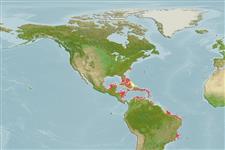Classification / Names
ชื่อสามัญ | ชื่อพ้อง | Catalog of Fishes(สกุล, ชนิด) | ITIS | CoL | WoRMS | Cloffa
>
Blenniiformes (Blennies) >
Chaenopsidae (Pike-, tube- and flagblennies)
Etymology: Emblemariopsis: Latin, emblema = insertion, inlaid work, raised ornament + Greek, opsis = appearance (Ref. 45335).
More on author: Ginsburg.
Environment: milieu / climate zone / depth range / distribution range
นิเวศวิทยา
เกี่ยวกับทะเล,น้ำเค็ม เกี่ยวกับหินโสโครก; ระดับความลึก 2 - 8 m (Ref. 40101). Tropical
Western Atlantic: endemic to Brazil (occurrence in other countries refer to other species).
ขนาด / น้ำหนัก / Age
Maturity: Lm ? range ? - ? cm
Max length : 3.3 cm SL เพศผู้/กระเทย; (Ref. 51458)
เงี่ยงครีบหลัง (รวม): 20 - 21; ก้านครีบอ่อนที่หาง (รวม): 11-13; เงี่ยงครีบก้น 2; ก้านครีบอ่อนที่ก้น: 20 - 22. This species is distinguished by the following characters: TP territorial males found in holes with a black head, with a dorsal overlay of small white spots; anterior dorsal fin blackened with a distal red band over a narrow white band and a thin white margin; the first dorsal-fin spine very long, when adpressed, reaching to 7th-11th spine base, about equal or well more than HL, the second spine often about 1/2-2/3 of first, the third spine about 1/3-1/2 of first, tenth spine up to 1/2 of first, the profile of anterior dorsal fin with a deep concavity (Ref. 125603).
Dark-shaded and pale TP with a similarly long first dorsal-fin spine and red band, with dark spots usually present along proximal spinous-dorsal-fin membranes forming a single row, no opercular bands or lines nor a row of dark spots along lateral midline or above lateral midline (Ref. 125603).
IP with elongated first two dorsal-fin spines, when adpressed, the first spine reaching to base of 5th-7th spine base, the second slightly shorter, third 1/2 of first (earlier IP and juvenile with less elongate spines). Colouration: live colors red, orange, and pink, but often brown and green (on darker backgrounds); cranial pattern with all bands prominent, pale bluish white or red, then breaking up, especially bands 2 and 3, forming a reticulated mosaic; IP head spots often full complement; melanophores near pectoral-fin base one to three spots (Ref. 125603).
Minimum depth range documented from Santa Catarina, South Brazil (S.Floeter, pers.comm. 04/10).
Life cycle and mating behavior
วัยเจริญพันธุ์ | การสืบพันธุ์ | การวางไข่ | เซลสืบพันธ์ของเพศเมีย(ไข่) | ความดกของไข่ | ตัวอ่อน
Victor, B.C., 2020. Review of the glass blennies (Teleostei: Chaenopsidae: Emblemariopsis) with two new species from the Caribbean Sea. J. Ocean Sci. Foundation 37:1-122. (Ref. 125603)
IUCN Red List Status (Ref. 130435)
Threat to humans
Harmless
Human uses
ข้อมูลเพิ่มเติม
ชื่อสามัญชื่อพ้องกลไกการเผาผลาญพลังงานผู้ล่าการศึกษาเกี่ยวกับผลกระทบของสารประกอบทางเคมีที่เป็นอันตรายต่อสิ่งมีชีวิต ประชากร และสิ่งแวดล้อมการสืบพันธุ์วัยเจริญพันธุ์การวางไข่การรวมกลุ่มวางไข่ความดกของไข่เซลสืบพันธ์ของเพศเมีย(ไข่)Egg development
อ้างอิงการเพาะเลี้ยงสัตว์น้ำประวัติการเพาะเลี้ยงสัตว์น้ำสายพันธุ์พันธุศาสตร์ElectrophoresesอัตราพันธุกรรมโรคการแปรรูปNutrientsMass conversion
ผู้ร่วมมือรูปภาพหลายรูปStamps, Coins Misc.เสียงปลามีพิษ เช่น ปลาปักเป้าความเร็วรูปแบบการว่ายน้ำพื้นที่เหงือกOtolithsสมองวิสัยทัศน์
เครื่องมือ
Special reports
Download XML
แหล่งที่มาจากอินเตอร์เน็ต
Estimates based on models
Preferred temperature (Ref.
123201): 24 - 28.2, mean 27.4 °C (based on 694 cells).
Phylogenetic diversity index (Ref.
82804): PD
50 = 0.5001 [Uniqueness, from 0.5 = low to 2.0 = high].
Bayesian length-weight: a=0.00457 (0.00183 - 0.01143), b=3.08 (2.86 - 3.30), in cm total length, based on LWR estimates for this (Sub)family-body shape (Ref.
93245).
ระดับชั้นอาหาร (Ref.
69278): 3.3 ±0.5 se; based on size and trophs of closest relatives
ความสามารถในการกลับคืนสู่ปกติ (Ref.
120179): ต่ำ, เวลาต่ำสุดที่จะทำให้ประชากรเพิ่มขึ้นเป็น 2 เท่าใช้เวลา 4.5 - 14 ปี (Fec assumed to be < 100).
Fishing Vulnerability (Ref.
59153): Low vulnerability (10 of 100).
Nutrients (Ref.
124155): Calcium = 246 [112, 535] mg/100g; Iron = 0.986 [0.519, 1.861] mg/100g; Protein = 17.9 [16.5, 19.1] %; Omega3 = 0.104 [0.047, 0.222] g/100g; Selenium = 13.3 [5.1, 36.2] μg/100g; VitaminA = 533 [144, 1,986] μg/100g; Zinc = 2.67 [1.61, 4.23] mg/100g (wet weight);
